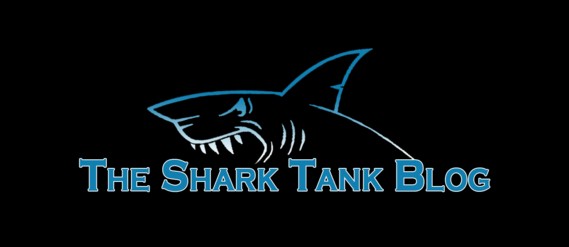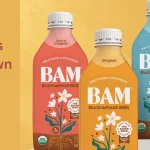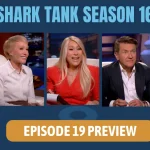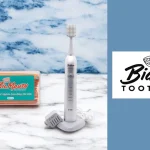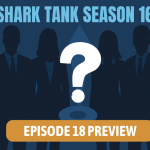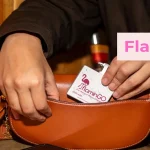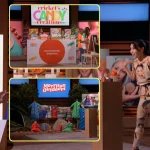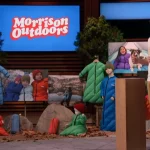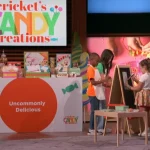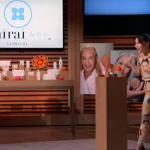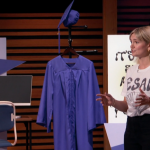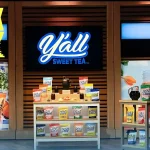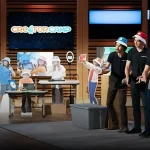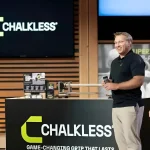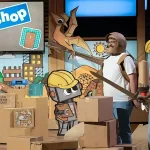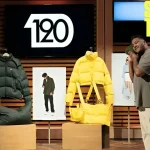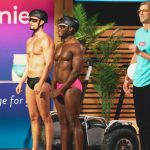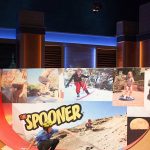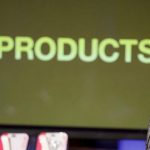Beyond the Tank Episode 201
 Beyond the Tank episode 201 aired Tuesday, January 5, 2016. In the première episode of the “second season” of the hit show, three past Shark Tank companies get an in-depth, 12-15 minute update segment on what their life is like after Shark Tank and viewers get to see them interacting with their investor/sharks. Beyond the Tank episode 201 features a look at Rick and Melissa Hinnant, the successful online retailer Barbara invested in during season 5. Bee Thinking didn’t get a deal with a Shark in season six, but Daymond mentored and became a customer of the company; see how that’s helped this business thrive. Scrub Daddy, which Lori invested in during season four, is the most successful Shark Tank product of all time, but success comes with growing pains.
Beyond the Tank episode 201 aired Tuesday, January 5, 2016. In the première episode of the “second season” of the hit show, three past Shark Tank companies get an in-depth, 12-15 minute update segment on what their life is like after Shark Tank and viewers get to see them interacting with their investor/sharks. Beyond the Tank episode 201 features a look at Rick and Melissa Hinnant, the successful online retailer Barbara invested in during season 5. Bee Thinking didn’t get a deal with a Shark in season six, but Daymond mentored and became a customer of the company; see how that’s helped this business thrive. Scrub Daddy, which Lori invested in during season four, is the most successful Shark Tank product of all time, but success comes with growing pains.
We’ll recap the “back stories” in Beyond the Tank Episode 201 here.
Beyond the Tank Episode 201 Featured Sharks
- Investor – Lori Grenier
- Investor – Daymond John
- Investor – Barbara Corcoran
Beyond the Tank Episode 201 Featured Entrepreneurs
- Company – Grace and Lace
- Company – Bee Thinking
- Company – Scrub Daddy
Beyond the Tank Episode 201 Recap
Melissa and Rick originally appeared on the Shark Tank in Season 5. Although they missed an opportunity to do a deal with Robert Herjavec, who wanted an answer to his offer before they heard from the other Sharks. “That was like a dagger in my heart,” said Aaron of Robert’s going out. “When Barbara stepped up to the plate, it was literally in the last seconds it felt unbelievable because it’s exactly what we wanted, with the exact partner. We were on cloud 9.”
Barbara was equally enthusiastic about the deal. “The second I met Aaron and Melissa, I loved everything about them.” As it turns out, Barbara’s instincts were right on the money. Grace and Lace exploded out of the gate.
The Grace and Lace motto is “triumph out of tragedy.” The loss of their daughter perpetuated the birth of Grace and Lace. Aaron remembers, “The pain of losing a child, a child that you’ve held in your hands, it is heart shattering.”
Melissa drew good from the devastating loss. “While I was in bed rest at the hospital, I learned to knit, and I found a lot of healing through creating.”
In the two years before Shark Tank, the couple managed $1 million in sales. One and a half years after Shark Tank, sales have grown to $12 million, and their employees have increased from six to thirty-six. The business that began in their home expanded to their garage, then to their current 3,000 square foot warehouse. The company has contracted for the building of a 6,000 square foot ware house, but weather has delayed the completion by more than six months.
In addition to the space constrictions, which are costing potential sales, there are problems in the design department. Melissa has spearheaded Grace and Lace’s success by designing all their products, but the increases in production are out pacing her ability to come up with new designs. “It makes me nervous to delegate design, because that’s what makes our company what it is,” says Melissa. Aaron understands. “The fabric of this company goes back to the loss of our daughter,” he explains.
Discussing the future with Melissa, Aaron is direct. “If you want to be the only person designing, and be in complete control of that, then we will flatline as a company this year.”
Still, Melissa is resistant to giving up control of the design process, a situation the couple hopes Barbara can help mitigate with her advice and insight.
Barbara Corcoran is thrilled with progress thus far of her investment. She says they’re “by far the most profitable business she’s invested in.” She understand that they’re facing challenges. “Aaron and Melissa have had the good fortune of having tremendous growth in this business in a very short period of time. But with that, comes big problems.”
The warehouse space is a huge problem, but the easier of the two to solve. Barbara recommends they sub-lease the space they need while they wait for the construction to be completed. The delays in the design process are more concerning. She wants to know why the couple haven’t hired a design team.
Melissa expresses her concerns. “My fear is, we go hiring these professionals, hiring these designers, that just start cranking out product, and that doesn’t make us Grace & Lace anymore.”
Barbara understands the situation, but explains that most companies the size of Grace and Lace have 4-6 designers on their team to avoid the delays the couple are faced with.
“It’s hard for Melissa to let go because the birth of this company happened while she was in the hospital waiting for the birth of her baby. Asking her to let go of the design process is like asking her to let go of that memory. It’s asking so much. But, this is a life or death situation for the company.” -Barbara
After hearing Melissa’s concerns, Barbara has a suggestion. She tells the couple they’ve been searching “too narrow” of a candidate pool, that the approach they’ve taken is “too thought out, and too educated.” She tells them they need to look for “kindred spirits” who have the same passion and vision Melissa brings to the table.
Barbara’s advice gets through to Melissa. “I think that Barbara challenged me to open my mind, but she also challenged us to go back to the way that we’ve always hired. We’ve hired people that we’ve loved first for who they were, and now I’ve realized my hands are still going to be in it, I’ll just be training and empowering people who are like me, to help me.” The couple designate Chris, their Operations Manager, to bring in a wider pool of potential candidates to meet Melissa and to begin building the team they need.
“What I love about being a Shark is, it’s just like being a Mom,” says Barbara with a cat-with-cream smile. “I’m a really good Mom. It’s not about making the money; but for me, it’s about seeing my kids do well, to see Rick and Melissa make their dream come true.”
Aaron and Melissa have new hope for their company after meeting with Barbara. Aaron says; “The loss of our daughter is not in vain, because we’re building something great, and we’re going to help a whole lot of people. The Grace & Lace family is only going to get bigger and stronger and better.”
With a little nudge from Mama Shark, Grace and Lace is well on its way to success.
Bee Thinking
When Matt Reed came to the Shark Tank in Season 6, he was armed with all kinds of information about colony collapse disorder and the effect the phenomena is having on the bee population. He promoted the ecological importance of backyard bee keeping to the Sharks, but failed to convey the potential profitability of the business. All of the Sharks went out one by one, and Matt left the stage without a Shark deal.
Daymond John was impressed, saying that although he wasn’t an investor, he would be a customer. “When Matt came in and was talking about the bee population,” recalls Daymond, “I was like most people. I looked at them as a nuisance. I had no idea.”
Since being on the Shark Tank, Matt has reassessed his valuation of the company and his approach to investors. “I’ve been pretty successful in life, so to fail at something, it’s pretty hard,” he admits. The addition of a child to his family has added pressure to succeed. “Having a young son dependent on us, it adds another level of risk. Now it’s even more important that we make Bee Thinking successful.”
Now Matt has a third-party vendor interested in his hives. This customer makes a proprietary bee hive accessory, and wants to partner with Matt to produce hives that include their accessory. This is a new legal landscape for Matt, and he doesn’t want to make any mistakes, especially since the order is for 16,000 hives, and includes pre-payment for the materials needed to build the hives. “By far the biggest order we’ve ever had with a single customer,” says Matt.
Fortunately, although Matt doesn’t have a Shark advisor, he does have a Shark customer. “Shortly after I was in the tank, Daymond did end up buying hives from us,” he explains. Daymond has invited Matt to his home in Upstate NY to see the hives in person and to discuss the business and how it’s doing now.
Daymond introduces him to a beekeeper he’s met, and shows him his “Scarecrow” which is a cardboard cutout of Kevin O’Leary. “Bees need to be protected, says Daymond, “and animals sense evil, so this works.”
O’Leary’s smiling cut out is protecting approximately 1 million bees, that are producing about 150lbs of honey for Daymond each year. Daymond’s bee keeping friend explains that about 90lbs of the honey must be left behind to feed the bees.
Matt is excited to see Daymond again. “The last time I saw Daymond, he said “I’m out” so I’m excited to talk to him outside of the Tank, and to share bees with him.”
Daymond John is looking forward to the meeting as well. “I’m almost obsessed with this journey to help save our planet and the bees. I never knew the value they had.”
At the second hive, Daymond has a cut out of Mark Cuban as a scarecrow. He’s putting his fellow Sharks to work, guarding his bees.
After viewing the hives, Daymond and Matt discuss the business. Daymond explains that he passed up the investment because the valuation was too high at $4 million. Matt was inexperienced, and overvalued his company, but since then the sales have grown, and he will clear $4 million in sales with the new order for hives. Daymond has timely advice for Matt on how to handle the deal. He immediately sees the potential pitfalls, telling Matt he has to protect himself and to prevent the company from simply designing and building their own hives and cutting him out of the picture entirely.
“You have to have some way to protect yourself,” he advises. “You need to have non-compete, and non-circumvent clauses.”
In addition to setting up strong legal defenses, Daymond recommends that Matt continue to expand customer education and grow his business. He tells Matt to begin creating affiliates all over the US, to multiply his knowledge and talents beyond his immediate reach as one person.
Daymond regrets not having gotten a chance to invest in Bee Thinking when it was in its infancy. “I would love to jump in and maybe help you, but you probably don’t need it,” he says, and Matt agrees. Daymond missed his opportunity to invest and Matt is in the position now of turning down a Shark’s offer of a deal.
Bee Thinking is abuzz with success, leaving one Shark a satisfied customer and a regretful non-investor.
Scrub Daddy
In Season 4, Lori Greiner and Daymond John got into a bidding war over Aaron Krause’s Scrub Daddy. After several back and forth offers, Lori landed the deal with Aaron, investing in what would become the most successful Shark Tank product of all time.
She was confident in the product from the beginning: “I invested in Scrub Daddy because I knew it was a hero. Plus, Aaron is driven, passionate, hardworking, the combination of the two for me, is magic.”
In the 4 months before appearing on Shark Tank, Aaron had managed to acquire $120,000 in sales. In the 3 years since his appearance, the company has exploded to $75 million in sales. Scrub Daddy now occupies a 35,000 square foot facility complete with automated packaging machines and pallet wrappers to help move the product more quickly through the warehouse.
Scrub Daddy now has six product lines, with four more in the pipeline. The addition of a 3D printer has reduced the time and cost it takes to produce prototypes, allowing Aaron to come up with several new products he’s excited to show Lori. “What we’re trying to develop here is a brand,” he explains, “And a brand isn’t a one-product company, so it’s very important that you continue to grow your product line so that you have staying power.”
There’s one problem. The German manufacturers of “flex texture;” the specialized material that Scrub Daddy is made from, are having trouble keeping up with demand. Since they’re the only suppliers of the material in the world, this is a real challenge to the continued growth of the company. A lack of supply could seriously inhibit production.
Aaron plans to meet with Lori, right after they put on a live QVC presentation of Scrub Daddy.
“QVC is so important to a product like Scrub Daddy,” explains Lori, “Because it is the perfect place to do a demonstration. But, it can be risky. If you don’t do well, you may not come back, but if you do well, you can do millions.”
Fortunately, Aaron has the presence and personality to pull off a successful appearance. Lori is thrilled. “Aaron did a fantastic job”
Right after the show, they meet to discuss the future of the product. He brings in some new products to show her.
Scrub-n-Erase is Scrub Daddy’s answer to Magic Eraser, an already wildly popular cleaning product. Scrub Mommy is a double sided version of the sponge, with a soft chamois on one side and the traditional Scrub Daddy material on the other. He’s also got Scrub Daisy, a sponge on a handle for hard to reach areas, and Mop Daddy, for cleaning floors.
Lori likes the Scrub Mommy, but believes the scrubbing side should be thinner. She recommends bringing out only one or two of the new product lines at a time, so as not to overwhelm the market with too many new things all at once.
They move on to the problem of supply. When Aaron explains the situation, Lori is alarmed. “We have worked so hard and come so far,” she exclaims. “We cannot afford to stop and slide backward now. We can’t not have material.”
Aaron plans to go to Germany in a couple weeks to meet with the suppliers. Lori says they can’t wait that long. She insists on getting a meeting much sooner and getting the Germans to come to the US. “Call them and say this is a crisis. We are their biggest customer.”
The Germans and their American counterparts come to a meeting with Aaron and Lori. The production challenges are caused, they explain, by the nature of the product.
“We use a special chemical raw material for your product, and it is stored in a tank. This tank is a certain capacity, and we are at the end of the capacity.” Normally capacity problems are solved by the use of a flexible system called a “tank farm,” but because of Scrub Daddy’s specific chemical requirements, it requires separate equipment dedicated solely to its manufacture and storage.
Lori suggests simply building more tanks to house the flex texture material. The suppliers explain that building a new tank would mean investing millions of euros for the manufacturer. Lori argues that the product is going to bring in the sales to cover the investment and more.
The manufacturer is uncertain. “You’re telling us you’re going to double your business, but what’s our guarantee that you’re going to double your business?” he asks.
Lori doesn’t waver. “Do you have any other product that’s grown as fast as the Scrub Daddy?” she shoots back. With $75 million in retail sales so far, and with exciting new product lines in the making, Lori is confident that sales will double, and even triple.
The German partners concede her point, and ask if Lori and Aaron will sign a contract promising a doubling of sales in the next 2 years.
Lori stipulates that the clock on the 2 year deadline to doubling sales doesn’t start running until the facilities are complete and in production. Signing the contract is a risk, but one she’s willing to take. It’s a calculated risk for Scrub Daddy, because breaching the contract could prove extremely expensive for the company, but it’s a chance Lori’s willing to take. “I’m absolutely confident that we’re going to be able to hit that number. We have strong, solid sales and we’re expanding, not only in the United States, and also in Europe. Now that they’re going to expand our capacity, I think we’re going to be able to actually make as many products as we want to. To me, that just means that SD is going to have explosive growth.”
Lori’s enthusiasm and confidence are infectious. Aaron is looking forward to a bright future with Scrub Daddy. “With no limits on our supply or capacity to grow, SD is free now, to become a world-wide recognized brand name. This amazing journey, that started with a smiley-faced sponge, ended up in the most successful product in the history of Shark Tank. I’m living proof that the American Dream is alive, and I feel like anything is possible.”

